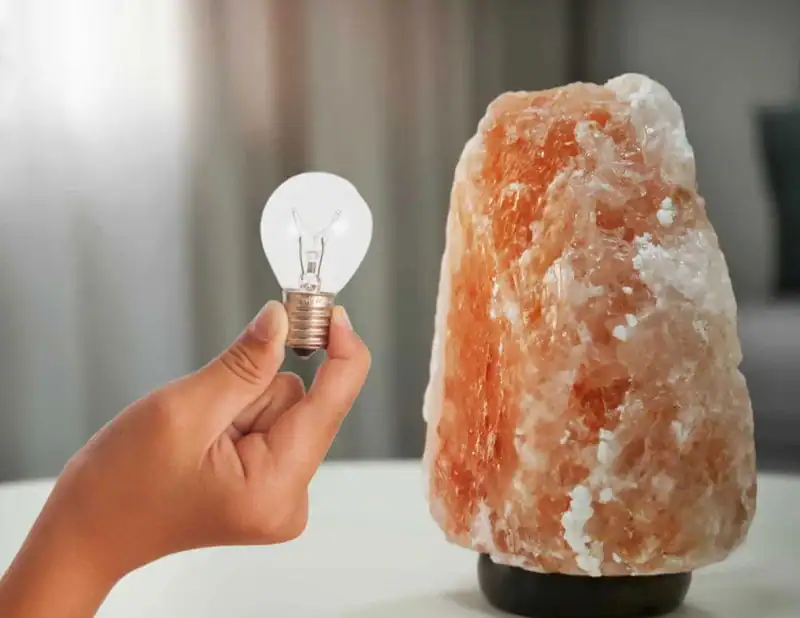Replacing a Salt Lamp Light Bulb
Salt lamps are a popular decorative piece that are believed to have a range of health benefits. They are made from blocks of natural salt and are lit using a bulb inside the lamp, which helps to create a warm, amber-colored light that is suitable for the natural look of the lamp.
But with so many different types of bulbs available, it can be confusing to know which one is the best choice for your salt lamp light bulb replacement. Many salt lamps have very small cavities that the bulb must fit within, limiting your choices in a replacement bulb. In this blog post, I’ll provide some tips and guidelines for choosing the right salt lamp light bulb, to ensure that it is safe, functions properly, and fits!
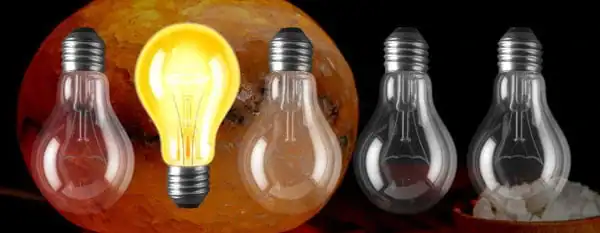
What Kind Of Bulbs Do You Use In Salt Lamps?
The type of bulb that is used can vary, but the most common type of bulb used in salt lamps is an incandescent light bulb with a low wattage value. These bulbs typically produce a warm, amber-colored light that is well-suited to the natural look of a salt lamp.
Other types of bulbs that can be used in salt lamps include LED bulbs, which are more energy-efficient than incandescent bulbs but won’t produce as much heat. It is important to choose a bulb that is the appropriate size and wattage for your salt lamp, to ensure that it is safe and functions properly.
Due to the limited amount of space within the salt block cavity, salt lamp makers tend to use very small bulbs. The safest and most convenient thing to do is to replace the bulb with a similar bulb.
Can You Replace The Bulb In A Salt Lamp?
As with any lamp, incandescent bulbs will eventually break or burn out and need to be replaced. In recent years, many Salt Lamps have started to come with LED bulbs, and these tend to last a very long time if the wires are cared for (they tend to be thin, especially if designed for a USB power source). Many times the LED bulb is integrated with the controls and power supply, so these units can be hard to replace if something goes wrong with them.
To remove the bulb in a salt lamp:
- Unplug the lamp and allow it to cool down if it has been recently used.
- Locate the bulb inside the lamp and carefully remove it by unscrewing it or pulling it out, depending on the design of the lamp.
- While taking the bulb out, look for any labels that the manufacturer has provided on the lamp. You are looking for letter/number combinations like ‘E12’ and ‘G11’ – more about those below!
- Don’t throw the old bulb out yet! It may be one of your only clues as to how to find a replacement bulb. Look carefully on the glass surface of the bulb and on the metal base – the letter/number combinations might also be printed there.
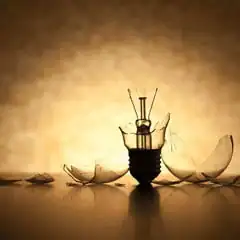
It is important to use a bulb that is the appropriate size and wattage for your salt lamp, to ensure that it is safe and functions properly.
What Do the Letters/Number Mean on a Bulb?
Bulb bases have a letter like ‘E’ for Edison, which means that the bulb has a standard style base that screws in. The number after it is the diameter in millimeters. So an ‘E12’ is the standard designation for a Candelabra base with a 12mm diameter (a little less than 1/2 inch). Other typical small bulbs might be ‘E16’. If your lamp has a bulb with two pins that slide into slots, that is called a mini Bi-Pin and the number denotes the spacing between the pins.
Bulb globes (the glass part) also have designators, starting with ‘G’ for Globe. A typical value for a small bulb used in Salt Lamps is ‘G12’. OK – here is where it gets goofy. Instead of a metric meaning, ‘G12’ means a globe diameter of 12 eighths of an inch – in other words 1.5 inches in diameter. So we’ve switched to English units for the glass part. Go figure.
So, now that you know what the values mean, you could measure the opening in your lamp base with a metric ruler and figure out the probable base size and measure the bulb diameter in inches and get an idea of the globe size.
Replacing a salt lamp light bulb is a relatively simple process, and can be done by most people with basic DIY skills. If you are unsure about how to replace the bulb in your salt lamp, you can refer to the manufacturer’s instructions or consult with a professional.
Where Do I Find Replacement Bulbs?
When you don’t know what you are looking for in a salt lamp light bulb, sometimes the best thing you can do is take the lamp and the original bulb to a local specialty light bulb store. If you’ve found good information on the salt lamp label, or if my explanation about how light bulbs sizes are described, you might be able to find the perfect bulb online. There certainly are a lot of choices – so you can get the perfect color temperature and wattage.
There are ‘a bazillion’ bulbs online, but I thought I would offer up one link for a typical small bulb that could be used in a Salt Lamp. If nothing else, it will get you to the right category for incandescent bulbs so you can start your search.
This is a package of 10 watt, 120volt, clear light bulbs with a Candelabra base (E12). The globe size is a G12.5, which is slightly larger than 1.5 inches in diameter. The supplier calls these 'warm white' but I could not find the color temperature value in the listing.
Can I Change to a Different Size of Bulb?
Sometimes you might decide you want more or less light output from your Salt Lamp bulb. Going smaller is usually easier than going bigger, just because Salt Lamps usually have limited space for the bulb.
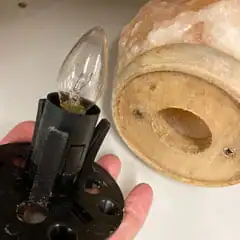
In this lamp, there was a tiny bulb designed for a night light, so the Salt Lamp was not very bright with this 7 watt bulb. But the cavity in the lamp was about 5 inches long overall. The base was an ‘E12’ Candelabra size, so I realized I could fit a taller bulb.
I decided my two replacement options were these:
Same Size Incandescent Bulb, but Higher Wattage: I found the exact size bulb, but it was a 15 watt bulb specifically designed for Salt Lamps and wax melting devices, so it puts out more light (and more heat) than a night light bulb.
LED Bulb that is Longer and Brighter: I found an Edison style LED with the same ‘E12’ base, but it is a 40 watt equivalent so it puts out a lot more light. Since LEDs don’t get very hot, I don’t have to worry about it being dangerous because it only draws 4 watts, which is less than the original light light bulb.
Since this is a very common combination of lamp size and bulb size with Salt Lamps, I thought I’d give you links the two bulbs I selected:
These bulbs are incandescent bulbs that are the same size as a night light bulb, but output 15 watts, so they are brighter and warmer. The base size is 'E12'. As you can see from the information in the listing, they were designed with Salt Lamps in mind.
This is an Edison style bulb: a little under 3.5 inches long and about 1 inch in diameter. Be sure to measure your Salt Lamp cavity to confirm that you have enough room for this bulb before ordering it as a replacement. The bulb draws only 4 watts, but has the light output similar to a 40 watt incandescent. The base size is 'E12'.
Are Incandescent Bulbs The Only Option For Use In A Salt Lamp?
While incandescent bulbs are well-suited to this purpose and are relatively inexpensive and easy to find, other types of bulbs can also be used in salt lamps, such as compact fluorescent and LEDs.
LED bulbs are also energy-efficient, and are available in a wide range of colors and styles. They are a long-lasting and durable option, but may not produce the same warm, amber glow as incandescent bulbs. Be sure to see the information below on ‘color temperature’.
Can Compact Fluorescent Bulbs Be Used In A Salt Lamp?
Compact fluorescent bulbs, can be a good choice for use in salt lamps because they are more energy-efficient than incandescent bulbs and can produce a similar warm, amber-colored light. Manufacturers tend to call these Compact Fluorescent Lamps using the acronym CFL or CFLs.
One advantage of using compact fluorescent bulbs in a salt lamp is their energy-efficiency. These bulbs use less energy than incandescent bulbs, which means that they can help to reduce energy costs and are more environmentally friendly. The University of Kentucky put together a really great summary in this PDF about Compact Fluorescent Lamp Replacement.
The major downside of CFLs is that they tend to be fairly large and are unlikely to fit in the small area within your salt lamp cavity, unless you have a very large salt lamp. CFL bulbs have a different numbering system than incandescent bulbs, so your best bet on replacing them with the same bulb is to find the bulb identification numbers on the bulb (usually printed on the base) or possible on the lamp socket. One of the reasons that CFLs are more efficient is that they don’t generate as much heat as an equivalently sized incandescent bulb. This is good for energy saving, but heating the salt is part of the salt lamp process.
They also have a longer lifespan than incandescent bulbs, meaning that they need to be replaced less often. In addition, compact fluorescent bulbs are available in a range of colors, including warm white and amber, which can be a nice choice for a salt lamp light bulb replacement.
Are LED Bulbs A Good Choice For Use In A Salt Lamp?
LED bulbs are a popular choice for use in salt lamps because they are energy-efficient and long-lasting, and are available in a wide range of colors and styles.
One advantage of using LED bulbs in a salt lamp is their energy-efficiency. LED bulbs use less energy than incandescent bulbs, which means that they can help to reduce energy costs and are more environmentally friendly. There are starting to be many more choices in LED bulbs where the manufacturers are offering them in the same form factors as incandescent bulbs (both base and globe size).
The downside of using a LED for a salt lamp is that the salt will not get nearly as warm which diminishes the negative ion effect of the lamp.
They also have a longer lifespan than incandescent bulbs, meaning that they need to be replaced less often. In addition, LED bulbs are available in a wide range of colors, including warm white and amber, which can help to create a cozy atmosphere in a room.
Why Limit Yourself to White?
While bulbs that emit a white light have been the traditional choice for salt lamps, replacing a salt lamp bulb gives you a chance to break the mold when you buy a new bulb. One of the very fun choices for bulb replacement is the Color Changing LED bulb. Credit goes to one of my site visitors for finding this great choice – and the pictures provided with the product show it with the different colored light being shown through various salt lamps.
The E12 base and approximate 2" length of this bulb make it a workable choice for most Salt Lamps. This LED bulb is color changing, and simply cycles through the available colors when it is illuminated.
What if the Salt Lamp Socket is Missing or Broken?
What are the options in the situation of the salt lamp bulb housing being missing or in bad shape? I see a lot of really nice looking Himalayan salt lamps in thrift shops, but it is obvious that one of the main reasons that they got donated is that the lamp holder is missing.
Most of the salt lamps I see have very simple setups. The bulb is held in place by a few plastic or metal clips that just stay in place by pressing onto the cavity drilled into the salt block itself.
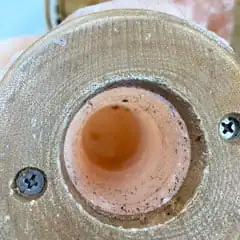
This is a typical interior cavity in a salt lamp: just a cylindrical hole. No tabs or fasteners for the bulb holder exist. The two Phillips head screws you see just hold the wooden base into the salt.
If your Himalayan salt lamp has a bad lamp socket - or if it doesn't have one at all, this is a clever choice to get your salt lamp glowing again! This small E12 socket comes with the matching dimmable bulb and the dimmer controls are conveniently located on the 6 foot long power cord. The assembly is held in place within your salt lamp cavity by two metal clips: just squeeze them together and insert into the lamp!
What Factors Should Be Considered When Choosing a Salt Lamp Light Bulb?
Once you’ve zeroed in on the exact size of bulb you need, what are the other factors that should be considered when selecting a replacement salt lamp light bulb?
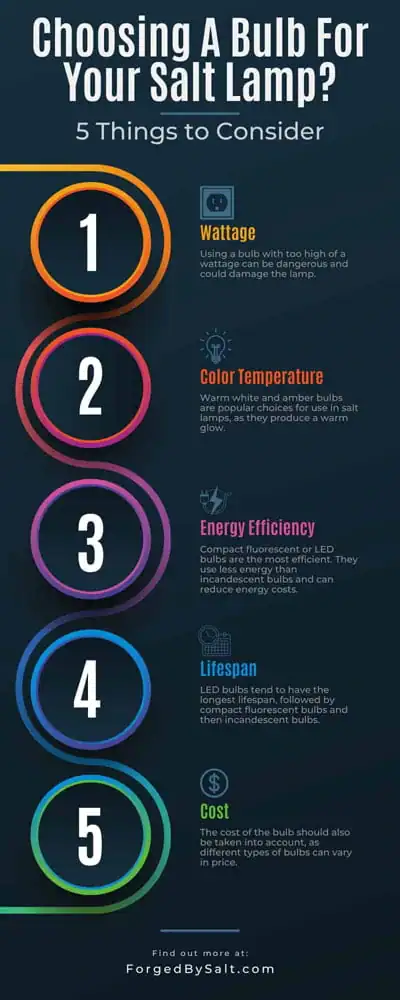
With any lamp, you always want to make sure that you use a bulb with the appropriate wattage, in addition to one that will actually fit inside your lamp.
- Wattage – The wattage of the bulb should be appropriate for the size and type of salt lamp that you are using. Typically you want to try to match the wattage of the original bulb or go lower in wattage. If you are replacing an incandescent bulb with an LED, this is not a concern because the LED in the same form factor will be a lower watt bulb than the original. Using a bulb with too high of a wattage can be dangerous and could potentially damage the Salt Lamp.
- Color Temperature – The color temperature of the bulb will affect the overall look and feel of the light produced by the lamp. Warm white and amber bulbs are popular choices for use in salt lamps, as they produce a cozy, warm glow. Manufacturers are starting to provide ‘Color Temperature’ values in units called ‘Kelvin’, so 2700 Kelvin can be called ‘soft white’ or ‘warm white’. 1800 Kelvin often is called ‘Amber’.
- Energy Efficiency – If energy efficiency is a concern, consider using a LED bulb in your salt lamp now that there are more choices for LEDs that are an exact size replacement for incandescent bulbs.
- Lifespan – The lifespan of the bulb is also an important factor to consider.
LED bulbs tend to have the longest lifespan, followed by compact fluorescent bulbs and then incandescent bulbs. - Cost – The cost of the bulb should also be taken into account, as different types of bulbs can vary in price.
By considering these factors, you can choose the best bulb for your salt lamp to ensure that it is safe, energy-efficient, and produces the desired light.
Why is it Important to Use the Correct Wattage of a Salt Lamp Light Bulb?
Using a bulb with too high of a wattage in a salt lamp could cause the lamp to overheat or break, leading to a fire hazard or other safety issues. On the other hand, using a bulb with too low of a wattage could result in insufficient light output, or may cause the lamp to function poorly.
The wattage of the bulb refers to the amount of electrical power that it uses, and it is important to use a bulb with the correct wattage in a salt lamp to ensure that it is safe and functions properly.
To find the correct wattage for your salt lamp, refer to the manufacturer’s recommendations. It is also a good idea to follow the general rule of thumb of using a bulb with a wattage that is equal to or slightly lower than the wattage rating of the lamp.
The original bulb in a salt lamp tends to range from 7 watts up to about 40 watts, with 15 watts being the most typical. The salt in your lamp can get fairly hot without being a safety hazard, but overheating the (often plastic) parts in the lamp base is not wise. Lamp bases are supposed to have a tag or printing on them that states the maximum wattage, but sometimes the tag is missing. When in doubt, stick to no more than 15 watts for an incandescent bulb or switch to a LED bulb if you’d like something brighter without running the lamp hotter.
Just remember that a salt lamp isn’t typically designed to provide significant light. It’s not a reading lamp, but rather a decorative piece that is meant to enhance relaxation while providing a soft glow.
Beyond Bulb Replacement – Troubleshooting
Sometimes you replace a salt lamp bulb, and the lamp will still not light up. Possible reasons for this might be:
- You bought the wrong bulb and perhaps it is not fitting in the socket correctly? You can try removing and re-tightening – and be sure to compare the new bulb to the old bulb for clues.
- The socket is no longer functional: look for signs of loose wiring or other visual clues. If you suspect you have a bad lamp socket, you need to just get rid of it because it can be a fire hazard if left plugged in.
- Try a different power outlet to test with. I HAVE DONE THIS: I tested using a normal looking wall outlet, only to realize that it was the switched outlet and the switch was in the ‘off’ position. The easiest thing to do is to try out the lamp at an outlet that you use all the time, like one in the kitchen or bathroom.

If you decide that you have a bad lamp socket, see the section above on replacing a bad lamp holder. If the replacement socket won’t work for the type of lamp you have, we explore some DIY Salt Lamp repair ideas in our article: Replacing A Salt Lamp: When To Know It’s Time.
Frequently Asked Questions
Why is my salt lamp not turning on?
The top four reasons that a salt lamp won’t light are: burned out bulb, a loose connection (bulb or plug into the electrical receptacle), a damaged switch, or a damaged cord. It is also possible that the problem could be outside the lamp itself: the outlet is switched off or the breaker was triggered. Try plugging your lamp into a different circuit that you know is working before diagnosing a bulb/lamp socket/cord issue.
Is it safe to leave a salt lamp on overnight?
Yes – as long as your lamp has a UL Certified lamp socket and cord, it is fine to leave your lamp on for long periods of time. Some people like to use salt lamps for night lights, for example. Keeping the lamp warm via the salt lamp light bulb being lit can also help with moisture accumulating within the salt.
Why does my bulb keep burning out?
The most likely cause of salt lamp bulb failure tends to be cheap bulbs. Other factors may include loose connection within the lamp bulb socket or a faulty cord. Consider replacing the lamp socket with a UL Certified lamp/cord assembly.
Can I use a dimmer switch with my salt lamp?
You can use a dimmer switch if the bulbs you are using are dimmable bulbs. In other words, it’s not a function of a salt lamp – it’s selecting the right bulb for the dimming circuit.
Dimmable bulbs are labeled on the original packaging, but may not be marked on the bulb itself, especially since salt lamp light bulbs tend to be small. One way that you can tell if a bulb is dimmable is to slowly move the switch on the dimmer. If you see a smooth change in the amount of light, then the bulb is suitable for the dimmer. If the bulb remains unlit or flickers, and then comes on fully when the dimmer switch is all the way up, the bulb should not be used with a dimmer.
What type of bulbs are not recommended for a salt lamp?
Factors that make bulbs unsuitable for a salt lamp include: the wattage is too high (bulb gets too hot) and bulb size/shape (bulb should not touch the salt directly).
Specific types of bulbs that should not be used include Halogen bulbs. These bulbs produce excessive heat and can cause the salt lamp to overheat or break, which could lead to a fire hazard or other safety issues.
Also note that while LED equivalent bulbs are available to replace the bulb in your lamp, a LED bulb will not warm the salt up as much as an incandescent bulb type.
What wattage is a salt lamp bulb?
The original bulb in a salt lamp tends to be incandescent bulbs that vary between 7 watts and 40 watts, but the most common wattage values are 15 or 20 watts. Check the lamp socket or cord for a label or printing that states the maximum wattage.
Final Thoughts
Incandescent bulbs are a common choice for use in salt lamps due to their warm, amber-colored light and relatively low cost. However, other options such as compact fluorescent bulbs and LED bulbs can also be used, and offer the added benefits of energy-efficiency and a longer lifespan.
Just choose a bulb that fits in with the manufacturers recommendations and doesn’t exceed wattage limitation.
Table of Contents
Need help selecting a new Salt Lamp for your space? Check out our article on Small To Large: The Perfect Himalayan Salt Lamp For Your Space.

